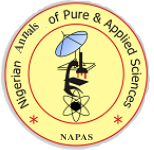Phytochemical Analysis, Nutritional Content and Evaluation of Antidiabetic Related Elements of Boswellia Dalzielii
DOI:
Keywords:
Boswellia dalzielii, Phytochemicals, Proximate, Elements.Abstract
The present study was aimed at investigating the phytochemical constituents, proximate content, and elemental levels of some mineral elements associated with anti-diabetic properties. Fresh leaf, stem, and root barks of Boswellia dalzielii were air-dried, pulverized, and extracted using the cold maceration method with 85% methanol. Proximate analysis was conducted following standard methods. The levels of the mineral elements were determined using Atomic Absorption Spectrometer. Results of the proximate content revealed that the increasing order of these nutrients among the plant parts is dry matter> carbohydrates > crude fiber> moisture content > ash content > crude protein > fats content. The elemental analysis revealed that Ca had the highest concentration (7.70E-01 mg/g), of all the plant parts the macro-elements analysed. Other macro-elements; K, Mg, and Na in the leaf had concentrations of 4.62E-03, 3.45E-01, and 7.65E-01 mg/kg respectively, while Zn had the highest concentration (9.91E-03) when compared to all the other microelements which were Cd, Cr, Cu, Fe, and Ni. The concentration of Na (7.20E-01 mg/g) was the highest in the stem bark of the plant while Cd had the lowest (4.15E-05 mg/g). Na had the highest concentration in the root with 6.55E-01 mg/g, while Fe had the lowest, 3.05E-04 mg/g. Lead was not detected in all the plant parts analysed. The phytochemical studies of the crude methanol leaf, stem, and root bark extracts revealed the presence of alkaloids, flavonoids, cardiac glycosides, tannins, saponins, and terpenoids. The proximate levels and elemental concentrations of the leaf of B. dalzielii were within the permissible limit set by WHO. Thus, Boswellia dalzielii contains phytochemicals and phytonutrients which might synergistically potentiate the antidiabetic activity of the plant.
.
Downloads
Published
How to Cite
Issue
Section
License
Copyright (c) 2022 J Yakubu, C A Maina , F I Abdulrahman, O A Sodipo , K A Andema , H A Dawi, M T Kolo

This work is licensed under a Creative Commons Attribution-ShareAlike 4.0 International License.



 Contact Us
Contact Us Editorial Team
Editorial Team Join As A Reviewer
Join As A Reviewer  Request For Print Copy
Request For Print Copy


 Cprint Publishers
Cprint Publishers